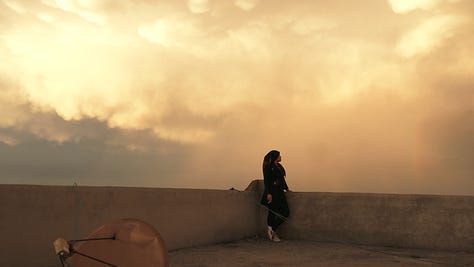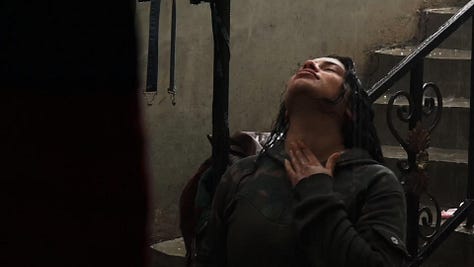Guns, Gender, and the Burden of Liberation
A review of Antonia Kilian’s documentary, "The Other Side of the River" which follows 19-year-old Hala as she flees Syria, joins a Kurdish women’s military unit, and returns home to fight for freedom.
In one training-camp scene from The Other Side of the River, a group of Kurdish girls giggle and pose with a pair of stylish sunglasses. For a brief moment, the dusty compound feels like a carefree schoolyard. But then 19-year-old Hala, their instructor, snatches the glasses back, and her voice cuts through the laughter: That’s enough, you are soldiers. This moment encapsulates the film’s core tension between youthful innocence and the demands of a revolutionary life. Antonia Kilian’s documentary follows Hala’s journey after she escapes an arranged marriage by crossing the Euphrates River into a Kurdish Women’s Protection Unit.
Having fled an ISIS-controlled hometown and a fate of forced marriage, Hala finds not only military training but also an education in feminist ideology on “the other side of the river.” For her and her fellow female fighters, the enemy is not just ISIS, but patriarchy itself. We watch as Hala gains the skills and conviction to fight—for both her own self-determination and the broader liberation of women under oppressive norms.
Empowered by her teachings and trainings, she vows to liberate her younger sisters back home—setting the stage not just for a rescue, but for an ideological war within her own family.
A key theme in The Other Side of the River is the ambivalent nature of empowerment when it comes down the barrel of a gun. In the Kurdish liberation context, a woman bearing arms may symbolize freedom from patriarchal violence and oppression. Hala’s Kalashnikov and uniform, however, come with a twist: she uses them as part of the local security forces, essentially a state-sanctioned power rather than a guerrilla insurgency. This raises questions about empowerment versus cooptation: is Hala truly liberated, or has she been absorbed into yet another hierarchical structure? The film invites us to consider whether her agency is genuine or exists only within the confines of a militarized, male-dominated institution that can itself reproduce another style of oppression.
Feminist theorist Judith Butler argues that gender is not an innate essence but “a repeated performance” shaped by social norms. In many ways, Hala’s decision to wear a military uniform and command soldiers constitutes a performance of masculinity that may conflict with traditional expectations of how a woman should behave. This performativity has subversive potential—it visibly destabilizes the patriarchal script that women are passive or weak. Yet Butler would likely ask: Does Hala’s militarized performance truly subvert patriarchy, or does it end up mirroring militarized masculinity under a different guise?
The rifle in Hala’s hands is an icon of liberation for her, but it’s also a tool of domination historically reserved for men. By arming herself, she asserts that her life (and other women’s lives) is worth defending—recalling how, during the French Revolution, women like Pauline Léon argued that the right to bear arms would transform women into full citizens. However, there’s an implicit warning here: adopting these weapons can risk reinforcing the very structures of domination one aims to dismantle. This debate extends beyond Hala’s world. Even in the United States today, some feminists frame gun ownership as empowerment. A 2018 survey found that while feminist-identifying women are generally less likely to own guns, those who do tend to carry them frequently and feel more empowered by firearms than men.
On the other hand, some may argue it’s not truly “feminist” to rely on guns for safety, noting that owning a gun often puts women at greater risk of violence rather than protecting them. The Other Side of the River subtly engages with the dilemma of liberation through violence, showing Hala’s empowerment within a structured military context and prompting us to ask whether real freedom can be achieved through such means.
Despite its heavy themes, the film’s approach is subtle, observational, and rich with human moments. Kilian avoids any preachy voiceover, instead letting the scenes speak for themselves. We see young female fighters bonding tenderly: braiding each other’s hair, singing, teasing, and sharing rare moments of levity amid the discipline. These vignettes of perseverance and sisterhood provide a crucial emotional counterpoint to the harshness of their circumstances.



Unlike fictionalized sisterhood tales such as Mustang (which, for Western audiences, wrapped teenage rebellion in a somewhat romanticized package), The Other Side of the River offers a raw, unvarnished depiction of militarized feminism. It forgoes any glossy filter, grounding us instead in the uncomfortably real context of very real oppression and armed resistance. This realism extends to the film’s depiction of ideological contradictions. In the military academy, Hala and the other young women are taught revolutionary feminist ideals, even being instructed to suppress personal desires or romantic relationships for the sake of the cause. Yet when Hala returns to her hometown, those lofty ideals crash against a wall of tradition.
The film shows how little the social fabric has changed there: family honor, religious conservatism, and community whispers all conspire to mark Hala as a pariah. Her own father had threatened to kill her for running away, and even her mother and sisters, though they love her, are frightened by how far she’s transgressed societal norms. She has liberated herself, but in doing so she has become a stranger in her own land—too free, too outspoken for a world that expected her to know her place.
The camera captures the loneliness in Hala’s eyes as she realizes that even some of the women she wants to save are not ready (or able) to join her cause. In some chilling yet telling moments, Hala talks about carrying a grenade and mentions the punishment of stoning with a disturbing stoicism that may allude to a coping mechanism that shows how normalized violence and trauma have become in her life. These nuanced touches ensure that the film never sanitizes Hala’s reality; instead, it paints an honest portrait of a young woman caught between revolutionary fervor and the intimate ache of family bonds.
In the end, The Other Side of the River leaves us with challenging questions about feminist agency, violence, and the price of freedom. It highlights the paradox of a women’s liberation movement that operates within an institution historically hostile to women. Can a patriarchal instrument like the military or police truly serve feminist ends? The film doesn’t offer easy answers. Hala’s story suggests that sometimes agency arises within and against existing power structures rather than outside them altogether. She chose to work inside the system available to her, turning a source of oppression into a conduit for rebellion. This is a complex form of empowerment, one that comes with moral ambiguities. It is both inspiring and unsettling to see a young woman break her society’s patriarchal chains—only to shoulder new ones, forged in the structure of military hierarchy.
Is Hala escaping the cage, or simply trading one cage for another? The documentary lets this ambiguity linger. The gun gives Hala power and dignity, but it also binds her to a life of perpetual struggle and vigilance. Her “militant feminism,” as one might call it, is courageous. She literally puts her life on the line to free others; yet it demands sacrifice of personal ease, safety, and even emotional fulfillment. By the final frames, the audience is left admiring Hala’s bravery and principled resolve, but also reckoning with the reality that liberation, especially in an environment as brutal as northern Syria, comes at a steep cost.
The Other Side of the River succeeds as a balanced and thought-provoking documentary because it embraces these contradictions. It celebrates the strength and sisterhood of Kurdish women who stand up to tyranny, while critically examining the limitations and dilemmas of their struggle. The result is a powerful portrait of militarized feminism that refuses to romanticize or simplify. Through Hala’s eyes, we witness a feminist revolution that is intensely personal and uncompromisingly political. A revolution that asks—and compels us to ask—what truly lies on the other side of the river for those fighting not just for survival, but for a new way of life.
Middle East Uncovered is powered by Ideas Beyond Borders. The views expressed in Middle East Uncovered are those of the authors and do not necessarily reflect the views of Ideas Beyond Borders.






